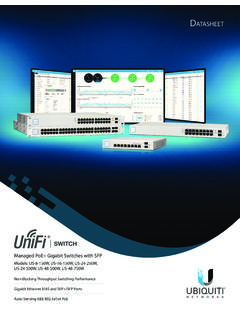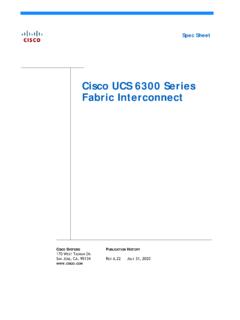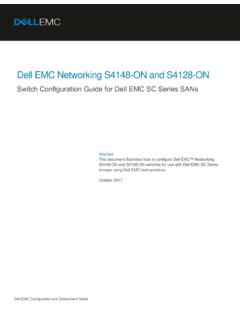Transcription of Smart Ports | Contents - Deloitte
1 Smart Ports | Contents 00 Smart Ports Point of View By Deloitte Port Services Smart Ports | Contents 01 Smart Ports | Contents Seaports are playing catch-up with the large transport & logistics players when it comes to developing insight driven solutions and IoT applications. Smart Ports | Contents 02 Contents Introduction 3 Need for Smart Ports is driven by industry challenges 6 From digital to Smart 10 Challenges ahead 16 About the authors 18 Smart Ports | Introduction 03 Introduction Currently, a tidal wave of technological innovation & integration is pushing industries and businesses to transform themselves in an effort to become more data, and insight-driven.
2 The port industry is no exception. Being part of both larger transport and logistics (T&L) supply chains and in itself being a cluster of companies and businesses active in the T&L sector, Ports are in a unique position to fully grasp the potential generated by these new high tech developments. Within the wider T&L sector, companies have begun experimenting with a range of connectivity and data-enabled technologies. In aggregate, these technologies form the Internet of Things (IoT), which represents a convergence between the physical and digital worlds, ultimately using data as a source of value.
3 These IoT technologies are being applied in diverse settings, from last mile transport optimization to warehouse and transport management systems. These developments have been accelerated by decentralized networks that rely on the rapid availability and analysis of information. Seaports are playing catch-up with the large T&L players when it comes to developing insight driven solutions and IoT applications. The current landscape offers some initial attempts at enhancing value propositions through technologies like automation but overall these projects remain isolated.
4 At the moment, Ports in Western Europe are leading the pack in these attempts. Although the Smart Port and IoT initiatives are commendable, there is still a long way to go before we can truly speak of fully integrated Ports that fully capitalize on the potential of IoT and insight driven applications, in other words true Smart Ports . Becoming a Smart Port means developing solutions to address the current and future challenges faced by seaports including spatial constraints, pressure on productivity, fiscal limitations, safety and security risks and sustainability.
5 Today s technological and business model innovations can be a driving force behind the Smart Port. However, determining which technologies, how to implement them and the way in which they can support the overall digital strategy of the port remains the main challenge. It stands to reason that Ports are faced with a myriad of issues both technical and strategic. The diverse nature of a port, with a wide variety of companies and ecosystems, operating different kinds of equipment and requiring different types of products and services creates a complicated environment with multiple stakeholders.
6 In addition to heterogeneity of data, a fear of transparency also remains a major issue. Ports are typically comprised of a cluster of competing companies. Thus, they are often very hesitant to share information with a central authority that has the ability to aggregate and distribute the data amongst the stakeholders involved. In addition the interaction with the surrounding environment, both ecological and social, adds an extra layer of complexity and opportunity to Smart Port development. Transport management systems are currently the number one IoT application in Ports .
7 Smart Ports | Introduction 04 One size fits all? A fully developed Smart port can use it gained insights for new business model generation. However not all Ports have the potential to integrate fully with their surroundings. Some Ports might lack infrastructure or physical integration with their surroundings or might simply not have the scale required to perform the necessary investments. The determination of which level of digitization that can be achieved should be performed on a case to case basis.
8 Smart Ports | Introduction 05 Smart Ports | Need for Smart Ports is driven by industry challenges 06 Need for Smart Ports is driven by industry challenges Ports operate within a supply demand model which is similar to the traditional T&L industry. On the supply side the Port Authority provides land for rent, services to clients as well as a regulatory framework. Smart Ports | Need for Smart Ports is driven by industry challenges 07 The demand side is comprised of both logistics supply (warehouses, transport providers, terminal operators) and demand (industrial sites, stowage companies, etc.)
9 And is therefore vastly different from the traditional T&L setup. When assessing the availability of technology in seaports, one must understand the demand supply balance. Seaports are often landlords , their business model revolves on supplying land and services to demand parties like terminal operators and companies acting in the T&L sector. Therefore, there is an important distinction between technological innovation on a terminal level and on a port level. A full port based IoT implementation should benefit both the port users as well as the port authority itself.
10 There are three main challenges driving the need for Smart Ports : 1. Operational excellence 2. Migrating activities (challenging external market) 3. New business opportunities These challenges stem from the tendency to measure success based on traditional parameters like size and throughput. However, Western Ports are no longer only competing for the number one spot in global traffic figures. Ports in Western Europe are faced with a concentration of Ports in a stagnating mature market where efficiency and protection of market share becomes central.















